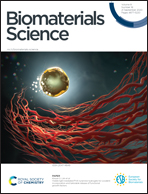Dendritic cell immune potency on 2D and in 3D collagen matrices†
Abstract
Dendritic cells (DCs) are antigen-presenting cells capable of either activating the immune response or inducing and maintaining immune tolerance. Understanding how biophysical properties affect DC behaviors will provide insight into the biology of a DC and its applications. In this work, we studied how cell culture dimensionality (two-dimensional (2D) and three-dimensional (3D)), and matrix density of 3D collagen matrices modulate differentiation and functions of DCs. Besides, we aimed to point out the different conceptual perspectives in modern immunological research, namely tissue-centric and cell-centric perspectives. The tissue-centric perspective intends to reveal how specific microenvironments dictate DC differentiation and in turn modulate DC functionalities, while the cell-centric perspective aims to demonstrate how pre-differentiated DCs behave in specific microenvironments. DC plasticity was characterized in terms of cell surface markers and cytokine secretion profiles. Subsequently, antigen internalization and T cell activation were quantified to demonstrate the cellular functions of immature DCs (iDCs) and mature DCs (mDCs), respectively. In the tissue-centric perspective, we found that expressed surface markers and secreted cytokines of both iDCs and mDCs are generally higher in 2D culture, while they are regulated by matrix density in 3D culture. In contrast, in the cell-centric perspective, we found enhanced expression of cell surface markers as well as distinct cytokine secretion profiles in both iDCs and mDCs. By analyzing cellular functions of cells in the tissue-centric perspective, we found matrix density dependence in antigen uptake by iDCs, as well as on mDC-mediated T cell proliferation in 3D cell culture. On the other hand, in the cell-centric perspective, both iDCs and mDCs appeared to lose their functional potentials to internalization antigen and T cell stimulation. Additionally, mDCs from tissue- and cell-centric perspectives modulated T cell differentiation by their distinct cytokine secretion profiles towards Th1 and Th17, respectively. In sum, our work emphasizes the importance of dimensionality, as well as collagen fibrillar density in the regulation of the immune response of DCs. Besides this, we demonstrated that the conceptual perspective of the experimental design could be an essential key point in research in immune cell–material interactions and biomaterial-based disease models of immunity.



 Please wait while we load your content...
Please wait while we load your content...